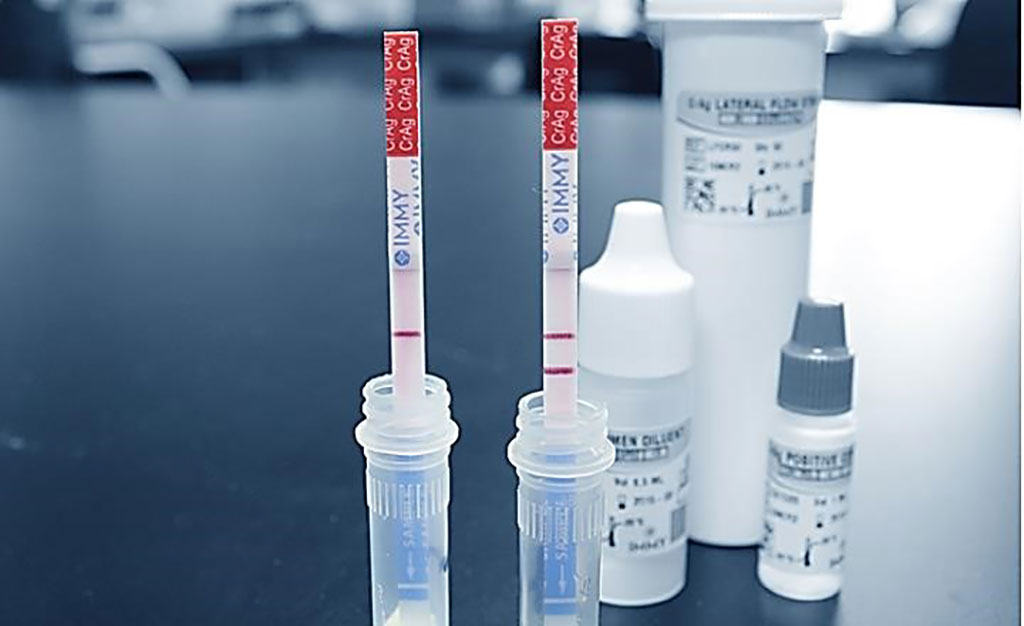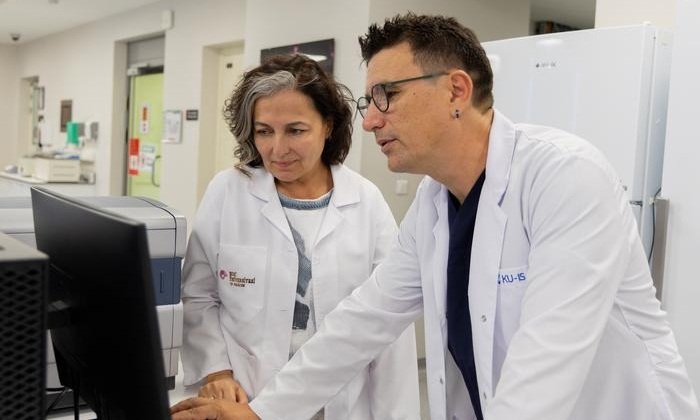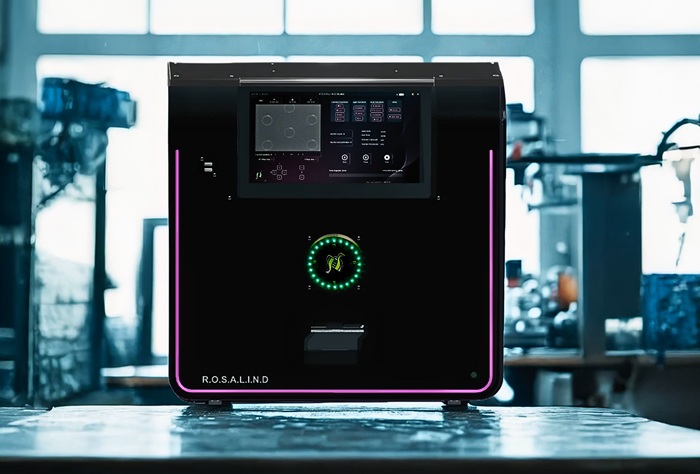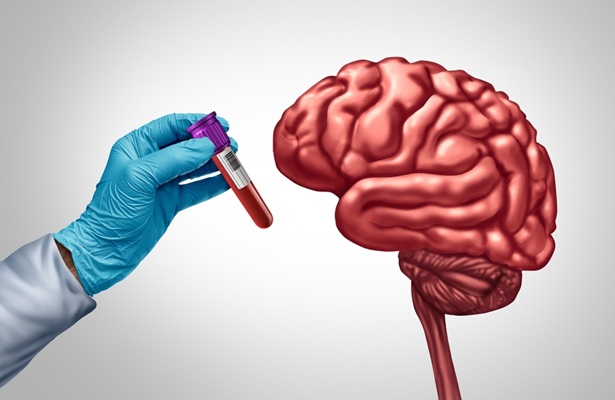Cryptococcal Antigen Screening Evaluated Among People Living with HIV
|
By LabMedica International staff writers Posted on 03 Jun 2021 |

Image: The CrAg LFA (lateral flow assay) can detect cryptococcal antigens in the blood of asymptomatic patients prior to development of cryptococcal meningitis enabling pre-emptive treatment of CrAg positive patients (Photo courtesy of Immy Diagnostics)
Cryptococcosis is a potentially fatal fungal disease caused by a few species of Cryptococcus (most often Cryptococcus neoformans or Cryptococcus gattii). Cryptococcosis is believed to be acquired by inhalation of the infectious propagule from the environment.
Most people in the USA who develop cryptococcal infections are HIV-positive. However, occasionally persons with no apparent immune system problems develop cryptococcosis. Cryptococcosis remains a leading cause of meningitis and mortality among people living with HIV (PLHIV) worldwide.
An international team of scientists led by the University of Washington (Seattle, WA, USA) evaluated laboratory-based cryptococcal antigen (CrAg) reflex testing and a clinic-based point-of-care (POC) CrAg screening intervention for preventing meningitis and mortality among PLHIV in South Africa. The team included 3,105 (39.4%) of 7,877 people screened were HIV-positive, of whom 908 had CD4 ≤200 cells/mm3 and were included in the analyses. The laboratory and clinical teams performed serum CrAg by enzyme immunoassay and lateral flow assay (Immy Diagnostics, Norman, OK, USA).
The investigators reported that Lab reflex and clinic-based testing significantly increased CrAg screening and diagnosis of CrAg-positive PLHIV. As compared to clinician-directed testing, clinic-based CrAg testing increased the number of PLHIV diagnosed with cryptococcal meningitis (4.5% compared to 1.5%), initiation of fluconazole pre-emptive therapy (7.2% compared to 2.5%), and initiation of ART (96.8% compared to 91.3%). Comparing clinic-based testing to lab reflex testing, there was no significant difference in the cumulative incidence of cryptococcal meningitis (4.5% compared to 4.1%) or mortality (8.1% compared to 9.9%).
The authors concluded that Lab reflex and clinic-based CrAg testing facilitated diagnosis of HIV-associated cryptococcosis and fluconazole initiation, but did not reduce cryptococcal meningitis or mortality. In this non-randomized cohort, clinical outcomes were similar between lab reflex testing and clinic-based point-of-care CrAg testing. The study was published on May 10, 2021 in the Journal of Acquired Immune Deficiency Syndromes.
Related Links:
University of Washington
Immy Diagnostics
Most people in the USA who develop cryptococcal infections are HIV-positive. However, occasionally persons with no apparent immune system problems develop cryptococcosis. Cryptococcosis remains a leading cause of meningitis and mortality among people living with HIV (PLHIV) worldwide.
An international team of scientists led by the University of Washington (Seattle, WA, USA) evaluated laboratory-based cryptococcal antigen (CrAg) reflex testing and a clinic-based point-of-care (POC) CrAg screening intervention for preventing meningitis and mortality among PLHIV in South Africa. The team included 3,105 (39.4%) of 7,877 people screened were HIV-positive, of whom 908 had CD4 ≤200 cells/mm3 and were included in the analyses. The laboratory and clinical teams performed serum CrAg by enzyme immunoassay and lateral flow assay (Immy Diagnostics, Norman, OK, USA).
The investigators reported that Lab reflex and clinic-based testing significantly increased CrAg screening and diagnosis of CrAg-positive PLHIV. As compared to clinician-directed testing, clinic-based CrAg testing increased the number of PLHIV diagnosed with cryptococcal meningitis (4.5% compared to 1.5%), initiation of fluconazole pre-emptive therapy (7.2% compared to 2.5%), and initiation of ART (96.8% compared to 91.3%). Comparing clinic-based testing to lab reflex testing, there was no significant difference in the cumulative incidence of cryptococcal meningitis (4.5% compared to 4.1%) or mortality (8.1% compared to 9.9%).
The authors concluded that Lab reflex and clinic-based CrAg testing facilitated diagnosis of HIV-associated cryptococcosis and fluconazole initiation, but did not reduce cryptococcal meningitis or mortality. In this non-randomized cohort, clinical outcomes were similar between lab reflex testing and clinic-based point-of-care CrAg testing. The study was published on May 10, 2021 in the Journal of Acquired Immune Deficiency Syndromes.
Related Links:
University of Washington
Immy Diagnostics
Latest Microbiology News
- New UTI Diagnosis Method Delivers Antibiotic Resistance Results 24 Hours Earlier
- Breakthroughs in Microbial Analysis to Enhance Disease Prediction
- Blood-Based Diagnostic Method Could Identify Pediatric LRTIs
- Rapid Diagnostic Test Matches Gold Standard for Sepsis Detection
- Rapid POC Tuberculosis Test Provides Results Within 15 Minutes
- Rapid Assay Identifies Bloodstream Infection Pathogens Directly from Patient Samples
- Blood-Based Molecular Signatures to Enable Rapid EPTB Diagnosis
- 15-Minute Blood Test Diagnoses Life-Threatening Infections in Children
- High-Throughput Enteric Panels Detect Multiple GI Bacterial Infections from Single Stool Swab Sample
- Fast Noninvasive Bedside Test Uses Sugar Fingerprint to Detect Fungal Infections
- Rapid Sepsis Diagnostic Device to Enable Personalized Critical Care for ICU Patients
- Microfluidic Platform Assesses Neutrophil Function in Sepsis Patients
- New Diagnostic Method Confirms Sepsis Infections Earlier
- New Markers Could Predict Risk of Severe Chlamydia Infection
- Portable Spectroscopy Rapidly and Noninvasively Detects Bacterial Species in Vaginal Fluid
- CRISPR-Based Saliva Test Detects Tuberculosis Directly from Sputum
Channels
Clinical Chemistry
view channel
Noninvasive Blood-Glucose Monitoring to Replace Finger Pricks for Diabetics
People with diabetes often need to measure their blood glucose multiple times a day, most commonly through finger-prick blood tests or implanted sensors. These methods can be painful, inconvenient, and... Read more
POC Breath Diagnostic System to Detect Pneumonia-Causing Pathogens
Pseudomonas aeruginosa is a major cause of hospital-acquired and ventilator-associated pneumonia, particularly in lung transplant recipients and patients with structural lung disease. Its ability to form... Read moreMolecular Diagnostics
view channel
World's First NGS-Based Diagnostic Platform Fully Automates Sample-To-Result Process Within Single Device
Rapid point-of-need diagnostics are of critical need, especially in the areas of infectious disease and cancer testing and monitoring. Now, a direct-from-specimen platform that performs genomic analysis... Read more
Rapid Diagnostic Breakthrough Simultaneously Detects Resistance and Virulence in Klebsiella Pneumoniae
Antibiotic resistance is a steadily escalating threat to global healthcare, making common infections harder to treat and increasing the risk of severe complications. One of the most concerning pathogens... Read moreHematology
view channel
MRD Tests Could Predict Survival in Leukemia Patients
Acute myeloid leukemia is an aggressive blood cancer that disrupts normal blood cell production and often relapses even after intensive treatment. Clinicians currently lack early, reliable markers to predict... Read more
Platelet Activity Blood Test in Middle Age Could Identify Early Alzheimer’s Risk
Early detection of Alzheimer’s disease remains one of the biggest unmet needs in neurology, particularly because the biological changes underlying the disorder begin decades before memory symptoms appear.... Read more
Microvesicles Measurement Could Detect Vascular Injury in Sickle Cell Disease Patients
Assessing disease severity in sickle cell disease (SCD) remains challenging, especially when trying to predict hemolysis, vascular injury, and risk of complications such as vaso-occlusive crises.... Read more
ADLM’s New Coagulation Testing Guidance to Improve Care for Patients on Blood Thinners
Direct oral anticoagulants (DOACs) are one of the most common types of blood thinners. Patients take them to prevent a host of complications that could arise from blood clotting, including stroke, deep... Read moreMicrobiology
view channel
New UTI Diagnosis Method Delivers Antibiotic Resistance Results 24 Hours Earlier
Urinary tract infections affect around 152 million people every year, making them one of the most common bacterial infections worldwide. In routine medical practice, diagnosis often relies on rapid urine... Read more
Breakthroughs in Microbial Analysis to Enhance Disease Prediction
Microorganisms shape human health, ecosystems, and the planet’s climate, yet identifying them and understanding how they are related remains a major scientific challenge. Even with modern DNA sequencing,... Read morePathology
view channel
AI Tool Simultaneously Identifies Genetic Mutations and Disease Type
Interpreting genetic test results remains a major challenge in modern medicine, particularly for rare and complex diseases. While existing tools can indicate whether a genetic mutation is harmful, they... Read more
Rapid Low-Cost Tests Can Prevent Child Deaths from Contaminated Medicinal Syrups
Medicinal syrups contaminated with toxic chemicals have caused the deaths of hundreds of children worldwide, exposing a critical gap in how these products are tested before reaching patients.... Read more
Tumor Signals in Saliva and Blood Enable Non-Invasive Monitoring of Head and Neck Cancer
Head and neck cancers are among the most aggressive malignancies worldwide, with nearly 900,000 new cases diagnosed each year. Monitoring these cancers for recurrence or relapse typically relies on tissue... Read moreTechnology
view channel
Diagnostic Chip Monitors Chemotherapy Effectiveness for Brain Cancer
Glioblastoma is one of the most aggressive and fatal brain cancers, with most patients surviving less than two years after diagnosis. Treatment is particularly challenging because the tumor infiltrates... Read more
Machine Learning Models Diagnose ALS Earlier Through Blood Biomarkers
Amyotrophic lateral sclerosis (ALS) is a rapidly progressive neurodegenerative disease that is notoriously difficult to diagnose in its early stages. Early symptoms often overlap with other neurological... Read moreIndustry
view channel
BD and Penn Institute Collaborate to Advance Immunotherapy through Flow Cytometry
BD (Becton, Dickinson and Company, Franklin Lakes, NJ, USA) has entered into a strategic collaboration with the Institute for Immunology and Immune Health (I3H, Philadelphia, PA, USA) at the University... Read more






















